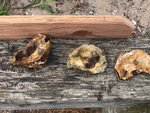
Brookhaven Town has a new oyster bar, located in Harts Cove in East Moriches. But this isn’t your ordinary oyster bar, like one you might find in downtown Patchogue; rather, it’s a man-made oyster reef, recently installed on town-owned bay bottom at the end of Moriches Island Road.
On Aug. 14, supervisor Ed Romaine and councilman Dan Panico joined officials from Moriches Bay Project, Cornell Cooperative Extension and Half Shells for Habitat at a press conference on-site to officially announce the completion of the town’s first-ever oyster bar.
Designed and constructed by Cornell Cooperative Extension, the oyster bar is made of aged shells, which were provided by Half Shells for Habitat — a nonprofit organization that collects shells from Long Island restaurants — as well as oyster larvae, otherwise known as spat. It measures 530 square feet, providing a natural habitat for sea life such as mussels, crabs and flounder. In addition, the oysters themselves act as natural filters, filtering as much as 50 gallons of water a day, per oyster. The oyster bar is a pilot project that will be monitored by the MBP and Cornell Cooperative Extension for a period of five years for oyster growth and survival, as well as the presence of other animals and plants living on the reef compared to nearby sandy bottom.
“Oysters are a keystone species in Moriches Bay. The more oysters, the healthier the bay,” explained Aram Terchunian, coastal geologist and co-founder of the MBP. “Oyster reefs are important because they are like English muffins — lots of nooks and crannies for things to grow and feed. The oyster reef is the keystone that provides focal point.”
According to Terchunian, man-made oyster reefs are somewhat new to Long Island, but are extremely beneficial because they mimic the natural reefs that supported a once highly sought-after market for Long Island oysters nationwide, and even worldwide. In fact, the oyster population in New York Harbor was the largest in the world when Henry Hudson arrived in 1609, according to the National Oceanic and Atmospheric Administration fisheries. There are a multitude of reasons why the oyster population greatly diminished over the years. Erosion from development, loss of wetlands and nutrient pollution are just some of the key contributing factors.
Although there are oyster reefs installed in both Riverhead and Southampton towns, noted Gregg Rivara, aquaculture specialist for Cornell Cooperative Extension, the Harts Cove oyster bar marks the first of its kind in Moriches Bay and in all of Brookhaven Town. However, the town has long been committed to cleaning its local waterways and has supported the MBP by donating hundreds of thousands of oysters grown in the town’s Shellfish Hatchery at Cedar Beach in Mt. Sinai, which have been used in the organization’s oyster farms located throughout Moriches Bay. In addition, the town provided oysters and the location for the MBP’s first solar power floating upweller system, which was recently installed at Maple Avenue Dock, also in East Moriches. Brookhaven will also provide as many as 70,000 oysters to the Harts Cove oyster bar reef.
“We need to reverse the damage done to our waterways by years of over-harvesting, neglect and pollutants.Working with the Moriches Bay Project and Cornell Cooperative Extension, we have established a partnership with a natural plan to filter the water with the oyster bar reefs. I am committed to protecting the environment and will continue to do whatever is needed to preserve it for years to come,” said Romaine.
MBP Co-founder Laura Fabrizio said that with the addition of the Harts Cove oyster bar, 750,000 oysters will have been put into Moriches Bay by year’s end; the group’s goal is one million.
“Our environment and economy are tied together here on Long Island, and clean water is of paramount importance,” added Panico. “Aside from putting hundreds of thousands of oysters in our bays with our partners, where each mature oyster filters up to 50 gallons of water a day, we plan to implement these oyster reefs throughout our local bays.”
Comments
No comments on this item Please log in to comment by clicking here